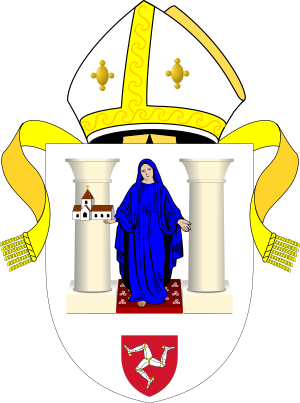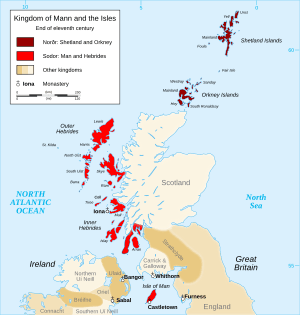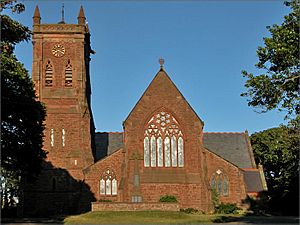Diocese of Sodor and Man facts for kids
Quick facts for kids Diocese of Sodor and ManDioecesis Sodorensis et Monensis |
|
|---|---|

Coat of arms
|
|
| Location | |
| Ecclesiastical province | York |
| Archdeaconries | Man |
| Deaneries | Castletown, Douglas, Peel, Ramsey |
| Statistics | |
| Parishes | 15 (in 14 benefices) |
| Churches | 43 |
| Information | |
| Denomination | Church of England |
| Cathedral | Peel Cathedral |
| Current leadership | |
| Bishop | Tricia Hillas, Bishop of Sodor and Man |
| Archdeacon | Irene Cowell, Archdeacon of Man |
| Website | |
| sodorandman.im | |
The Diocese of Sodor and Man is a special area of the Church of England. It's like a church district. It's one of only two Church of England dioceses that are not part of the United Kingdom. The other one is the Diocese in Europe.
Even though it used to be much bigger, today this diocese only covers the Isle of Man and the small islands nearby. The main office for the bishop is in Douglas. The main church, called the cathedral, is in Peel. People usually call it "Sodor and Man," not just "Sodor" or "Man."
Contents
How the Diocese Works
The Diocese of Sodor and Man looks after 40 churches. These churches are grouped into 15 church areas called parishes. There used to be more parishes, but they were reorganized between 2012 and 2015. Each parish usually has its own priest. Some parishes, like Onchan, Lonan, and Laxey, work together in a "team ministry" with a main rector and a team vicar.
The main church, St German at Peel, is one of five churches in the West Coast parish. The priest for this parish is also the Dean of the Cathedral.
The parishes are also grouped into four "Mission Partnerships." These are Eastern, Western, Southern, and Northern. They help churches work together on projects and support each other. These partnerships became official in 2013. They have taken the place of older church groupings called "rural deaneries." Each partnership has a team leader chosen by the bishop.
Besides the priests in parishes, the bishop also allows a few special priests called chaplains to work in other places. For example, there's a chaplain at King William's College, a school, and another at Noble’s Hospital, the island's main hospital. These chaplains help people with their spiritual needs in these places.
A Look Back: Early History

The name "Sodor" comes from the Norse word Suðreyjar, which means "southern isles." This was to tell them apart from the "northern isles" like Orkney and Shetland. The Isle of Man was part of these southern islands.
The Diocese of Sodor was first created in 1154 by Norway. It included the Hebrides and other islands along the west coast of Scotland. It was part of a larger church area led by the archbishop in Nidaros (now Trondheim), Norway.
Norway controlled these islands until 1266, when they became part of Scotland. The Isle of Man later became connected to the Kings of England in 1334. It was then ruled by powerful families, like the Stanleys and the Dukes of Atholl. In 1765, the British Crown bought the lordship of the island.
The right to choose the Bishop of Sodor and Man belonged to the Lords of Man. This continued until 1828, when it was given to the Crown. The Isle of Man is not part of the United Kingdom. Instead, it is a Crown Dependency, which means it's directly linked to the British Crown but governs itself.
During the English Reformation under King Henry VIII, the Diocese of Sodor and Man, like the rest of the Church of England, separated from the Roman Catholic Church. The bishop at the time, Thomas Stanley, didn't fully agree with the changes. He was removed from his position by Henry VIII. He was briefly put back in charge by Queen Mary I, but then removed again under Queen Elizabeth I.
Because the Isle of Man was not part of the Kingdom of England, some laws, like the Act of Uniformity of 1662, did not apply there. This allowed Bishop Thomas Wilson (who was bishop from 1697 to 1755) to introduce church services in the Manx language.
Why "Sodor and Man"?
As mentioned, "Sodor" meant the "southern islands," which included the Isle of Man. The extra "and Man" might have been added later, perhaps in the 1600s. Some people think that St Patrick's Isle, where the first cathedral was, might have become known as "Sodor" itself.
By the late 1500s, "Sodor" and "Man" were often used to mean the same thing. So, in legal papers, the bishopric might be called "Sodor," "Man," or "Sodor and Man" to be very clear.
Until 1604, bishops signed their names as "Sodorensis." From 1604 to 1684, they sometimes used "Soderensis" and sometimes "Sodor and Man." From 1684 until 2007, all bishops signed as "Sodor and Man" or "Sodor and Mann." However, the current bishop signs as "Sodor as Mannin." This is the name in the Manx Gaelic language. Her predecessor also used this Manx name.
More Recent History
The first main church (cathedral) for the Diocese of Sodor and Man was on St Patrick's Isle in Peel. This old cathedral stopped being used in the 1700s. For many years, the bishop's own chapel at Bishopscourt served as the temporary cathedral. This chapel was rebuilt in 1814 and again in 1858.
In 1979, Bishopscourt was sold. The next year, in 1980, the parish church of St German in Peel was officially named the "Cathedral Church of St German" by a special law from the Tynwald, the Isle of Man's parliament.
There were ideas in 1836 and 1875 to combine the Diocese of Sodor and Man with other dioceses in England, like the Diocese of Carlisle or the Anglican Diocese of Liverpool. However, these ideas were not approved.
Since the Isle of Man is not part of the United Kingdom, the Bishop of Sodor and Man does not sit in the House of Lords in the UK Parliament. However, the bishop is an important member of the Legislative Council of the Isle of Man, which helps make laws for the island.
The appointment of the bishop is still advised by the Prime Minister of the United Kingdom. But unlike bishops in England, who are formally elected, the Bishop of Sodor and Man is chosen directly by the monarch.
Churches in the Diocese
The Diocese of Sodor and Man has many churches across the island. Here's a quick look at how they are organized:
Church Statistics
| Paid clergy | Churches | Population served | People per clergy | People per church | Churches per clergy |
|---|---|---|---|---|---|
| 12 | 31 | 83,314 (2016 census) | 6,942 | 2,687 | 2.6 |
Eastern Mission Partnership
This partnership includes churches in areas like Douglas, Braddan, Onchan, Lonan, and Laxey.
| Benefice | Main Churches |
|---|---|
| Braddan | Kirk Braddan (St Brendan), Old Kirk Braddan |
| St George and All Saints, Douglas | St George, Douglas |
| St Matthew, Douglas | St Matthew the Apostle, Douglas |
| St Ninian, Douglas | St Ninian, Douglas |
| St Thomas, Douglas | St Thomas the Apostle, Douglas |
| Onchan, Lonan and Laxey | St Peter, Onchan; Christ Church, Laxey |
Northern Mission Partnership
This partnership covers churches in the northern parts of the island, including Andreas, Ballaugh, Jurby, Sulby, Bride, Ramsey, Glen Auldyn, Maughold, and Dhoon.
| Benefice | Main Churches |
|---|---|
| The Northern Plain | Kirk Andreas (St Andrew), St Jude, Kirk Ballaugh (St Mary the Virgin), St Mary de Ballaugh, Kirk Jurby (St Patrick), St Stephen, Sulby |
| Ramsey and the North East | Kirk Bride (St Bridget), St Olave, North Ramsey, St Fingan, Glen Auldyn, Kirk Maughold (St Maughold), Christ Church, Dhoon, St Paul, Ramsey |
Southern Mission Partnership
This partnership includes churches in the southern areas like Arbory, Castletown, Malew, Santan, and Rushen.
| Benefice | Main Churches |
|---|---|
| Arbory and Castletown | Kirk Arbory (St Columba, Ballabeg), St Mary's on the Harbour, Castletown |
| Malew and Santan | Kirk Malew (St Lupus), St Mary the Virgin, Ballasalla, St Mark, St Mark's, Kirk Santan (St Sanctain) |
| Rushen | Kirk Christ Rushen (Holy Trinity), St Catherine, Port Erin, St Mary, Port St Mary, St Peter, Cregneash |
Western Mission Partnership
This partnership covers churches on the west coast, including Marown, Foxdale, Baldwin, Peel, St John's, Kirk Michael, Patrick, and Dalby.
| Benefice | Main Churches |
|---|---|
| Marown, Foxdale and Baldwin | Kirk Marown (St Runius), Old Kirk Marown, St Paul, Foxdale, St Luke, Baldwin |
| The West Coast | Cathedral Church of St German, Peel, St John the Baptist (Royal Chapel), St John's, Kirk Michael (St Michael & All Angels, Kirk Michael), Kirk Patrick (Holy Trinity, Patrick), St James, Dalby |
In Books and Shows
The fictional Island of Sodor, which is the main setting for The Railway Series books and the Thomas & Friends TV show, is named after this diocese. It is even said to be part of the diocese in the stories!
See also
- List of churches on the Isle of Man
- Bishop of Sodor and Man
- Bishop of the Isles
- List of Church of England dioceses
- Sodor (fictional island)



